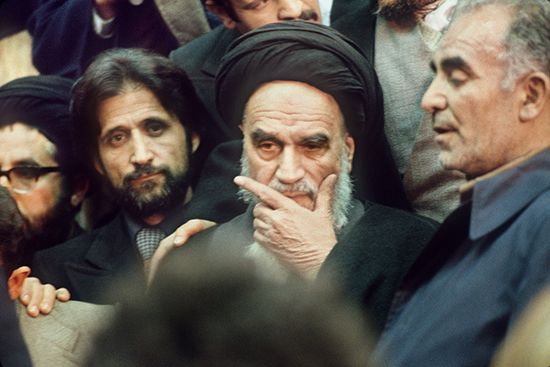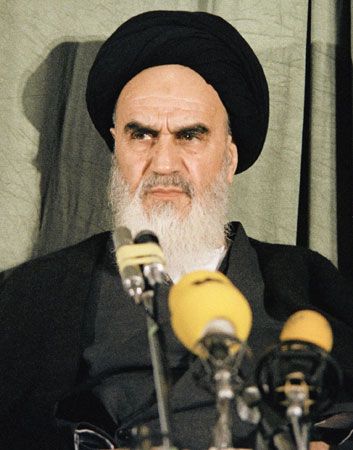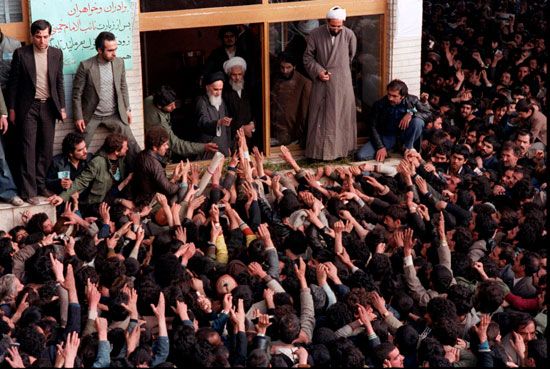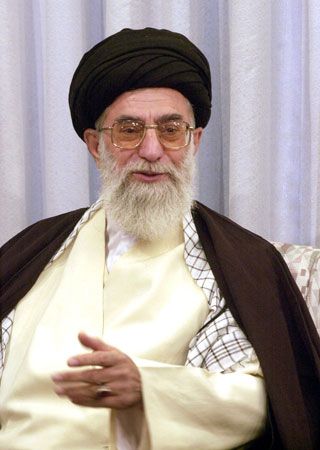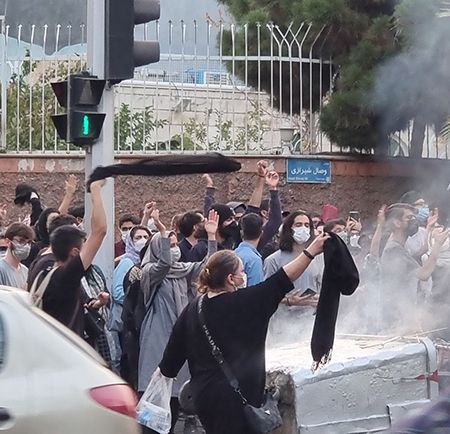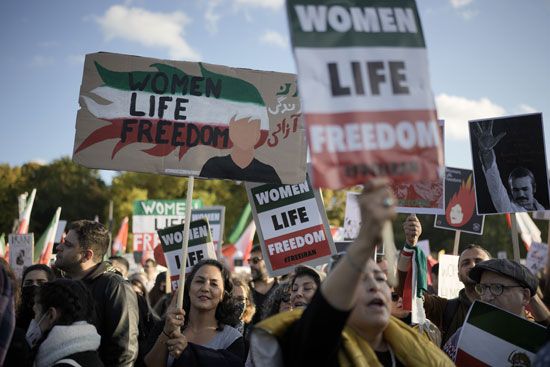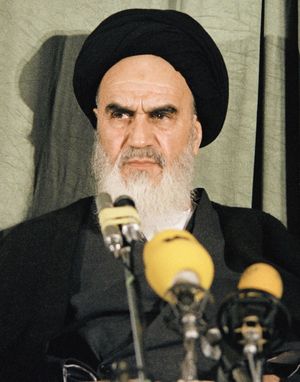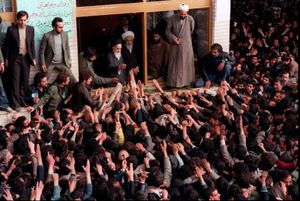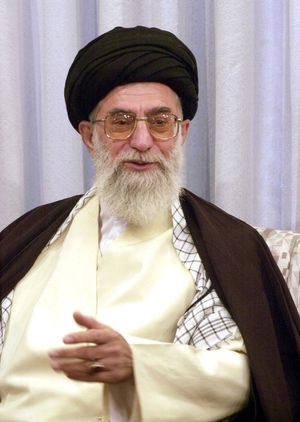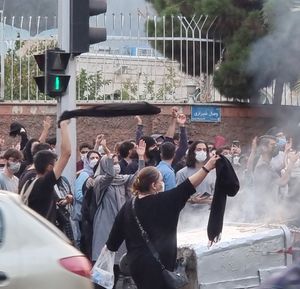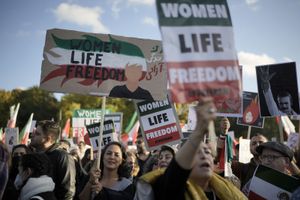supreme leader of Iran
- Formally:
- leader (Persian: rahbar)
- Related Topics:
- Iran
- head of state
supreme leader of Iran, head of state in Iran, overseeing virtually all functions of government either directly or indirectly. The post was instituted as rahbar (“leader”) in 1979 with the creation of Iran’s Islamic Republic, which blends democratic elements with theocratic oversight from Islamic clerics of the Twelver Shiʿi sect. Although Iran’s president and legislature are directly elected by the Iranian people, the concentration of power in the hands of the rahbar returned Iran to a dictatorship in which the rahbar commands tremendous sway over both policy making and the electoral process.
Colloquially, Ruhollah Khomeini and Ali Khamenei, Iran’s first two rahbars, have often been called “the ayatollah.” However, that title reflects their clerical rank rather than their political position. The formal title of Iran’s supreme leader, rahbar, translates, simply, as “leader,” while the title of ayatollah belongs to a great number of clerics among the Twelver Shiʿah.
Formal powers and duties
The duties designated for the rahbar in the constitution are broadly defined, allowing significant room for the rahbar to intervene in political affairs, maneuver the armed forces, and make appointments that determine the makeup of the government. The powers delineated in Article 110 include:
- determining the political direction of the government (in consultation with an advisory committee);
- overseeing the correct implementation of the general policies of the government;
- calling referenda;
- commanding the armed forces;
- declaring war, peace, and the mobilization of armed forces;
- appointing and dismissing:
- six of the twelve jurists of the Council of Guardians;
- the head of the judiciary;
- the head of the state broadcasting agency;
- the chief of the general staff;
- the commander in chief of the Islamic Revolutionary Guard Corps (IRGC);
- the highest commanders of the armed forces and security bodies;
- resolving issues in governance that cannot be settled through ordinary means;
- approving the appointment of the president after the presidential election;
- dismissing the president after a judicial conviction or legislative vote of no confidence;
- pardoning or commuting sentences upon recommendation of the head of the judiciary.
Qualification and selection
The post of rahbar was created for Ruhollah Khomeini, the architect of the Islamic Revolution in 1979, who held the high and rarely bestowed clerical rank of marjaʿ-e taqlīd (“religious jurist worthy of emulation”). The constitution made that rank an essential qualification for the position, but the requirement was removed in 1989 to allow Ali Khamenei, who had a low clerical rank, to become rahbar. Amendments lowered the qualification to any jurist of Islamic law who is judged to be just and pious and can project political and social leadership.
The rahbar is selected by the Assembly of Experts, a deliberative body of Islamic jurists who are directly elected every eight years (although the jurists must first be approved by the Council of Guardians in order to run). The Assembly may also remove the rahbar if it deems that he is no longer qualified.
Evolution of the post and its expansion of power
Leadership of Ruhollah Khomeini (1979–89)
As an outspoken critic of the Pahlavi dynasty in the 1960s and ’70s, the exiled Shiʿi scholar Ruhollah Khomeini formulated a theory of government (known as velāyat-e faqīh) in which lawmakers and administrators would work within the guidance of the Shiʿi cleric most advanced in knowledge (ʿilm) and piety. The idea—a government constrained by a guide who embodies the values of the nation—had popular appeal among many Iranians disaffected by the draconian measures of the Pahlavi shah. When Mohammad Reza Shah Pahlavi fled Iran in 1979, Khomeini returned from exile in France to rejoicing crowds, and he was hailed as the guiding figure of the Iranian Revolution.
Khomeini’s vision of government was promulgated by referendum that same year, and he was enshrined in the constitution as the country’s leader. Although popularly acclaimed, he hardly proved impartial as rahbar: when hard-liners and conservative clerics cracked down on dissent or imposed religious edicts, he either remained silent or gave his explicit approval. These measures stabilized the Islamic Republic after years of turmoil, staving off a number of existential challenges from remnants of the shah’s regime, insurgents, and an all-out war with Iraq (1980–88; see Iran-Iraq War). But they also entrenched the repressive elements associated with the Iranian regime in the 21st century, including a strict code of dress (ḥijāb) and public conduct (ʿifāf), a strong executive authority, and a powerful military branch accountable to the rahbar alone, the Islamic Revolutionary Guard Corps (IRGC).
Leadership of Ali Khamenei (1989– )
Out of that era of stabilization rose Ali Khamenei, a negotiator in the Iran hostage crisis, an erstwhile commander of the IRGC, and a leading partisan of the conservative faction of clerics often referred to as the Principlists. When Khomeini’s designated successor, Hossein Ali Montazeri, lost his position in 1988 after speaking out against human rights abuses, Khamenei postured himself to become the alternative candidate. But because he had neither the stature nor the popular following to be considered the country’s spiritual leader, he was made provisional rahbar upon Khomeini’s death in 1989 while an amended constitution was brought to referendum to allow him to take the reins. The amendments also eliminated the post of prime minister and expanded the role of both the rahbar and the president.
In the years that followed, Khamenei greatly extended the bureaucratic reach of his post, not least through the Office of the Supreme Leader (Bayt-e Rahbārī). Under Khomeini the Office had consisted of a handful of close advisers and envoys, as was typical for any high-ranking cleric. Under Khamenei the Office grew into a parallel administration, with members specially designated as liaisons to certain government entities and a staff of administrators that numbered in the thousands. The Office also gained oversight of the clerical hierarchy through the creation of committees that managed administration of and state funding to religious institutions. Furthermore, it exerted influence through its direct control over a considerable amount of alms and many sizable charitable trusts (bonyads). Meanwhile, the IRGC evolved into the country’s preeminent security force, and its strength took on a new dimension as its members were given substantial roles in the economic development of postwar Iran.
In the late 1990s Khamenei began using his pull to rein in the elected government. At the close of the Iran-Iraq War, the mood of Iran had been one of liberalization and rapprochement with the West. For several years Hashemi Rafsanjani, a trusted member of Khamenei’s revolutionary cohort and the first president (1989–97) under Khamenei, balanced the rahbar’s preoccupation with the Islamic Republic’s security and stability on the one hand with policies that allowed greater cultural openness and renewed relations with Europe on the other. But the openness brought Khamenei’s vision for Iran under threat in 1997 when Iranians overwhelmingly elected a reformist, Mohammad Khatami, as president. He had campaigned on a platform of curbing censorship, fighting religious excess, and allowing for greater tolerance. Khatami’s presidency was marked by considerable friction between the reformists and the conservative Principlists as the reformist faction gained momentum and Khamenei’s allies in the parliament, judiciary, and IRGC removed, prosecuted, or harassed many of Khatami’s associates and supporters. While many reformists openly debated the antidemocratic nature of the office of the rahbar—some even calling for the removal of the post from the constitution—Khamenei authorized the establishment of a new intelligence wing within the IRGC that would later rival the Ministry of Intelligence under Iran’s presidency.
At the end of Khatami’s presidency, in 2005, Khamenei and his supporters began working to ensure that elections would produce victors who were loyal. When Mahmoud Ahmadinejad, a lesser-known conservative, beat Rafsanjani, the apparent front-runner, in the presidential election, members of the Office of the Supreme Leader were accused of leveraging their resources to effect the outcome. Interference in the election was much more glaring to Iranians in 2009 when Ahmadinejad, who was mired in controversy, won that year’s election by a mysteriously large margin. The official results prompted a massive protest movement, which was subdued by a brutal crackdown and met with a massive expansion of the rahbar’s security apparatus. Khamenei’s grip loosened slightly in the 2010s as Hassan Rouhani, a centrist who had previously led international negotiations on Iran’s nuclear program, pursued a nuclear deal with the West that would lift sanctions on Iran. But after the United States unilaterally withdrew from the deal in 2018 and reimposed its sanctions, Khamenei and his allies imposed their strictest limits on elections yet. In 2020 nearly 7,000 candidates were disqualified from parliamentary elections, leaving four-fifths of the legislature’s seats entirely uncontested by reformists. In the presidential election of 2021, Ebrahim Raisi—a loyalist close to Khamenei—was the only high-profile candidate to qualify, allowing him to breeze to a landslide victory. Rouhani, meanwhile, was later disqualified from running for a fourth term in the Assembly of Experts in 2024.
The level of repression under Khamenei, which was exacerbated by the economic turmoil from international sanctions, prompted many observers to question the future of the rahbar position in a post-Khamenei era. As he stacked the government with loyalists, Iranians lost opportunities to voice their grievances. In 2022 the regime attempted to stabilize a restless Iranian society by increasing surveillance and censorship, including the enforcement of religious norms by the Gasht-e Ershad (morality police). The attempt backfired when a young Kurdish woman, Jina Mahsa Amini, died while in the custody of the Gasht-e Ershad for wearing “improper” clothing. Her death set off an unprecedented wave of unrest in late 2022 that took aim at the regime’s imposition of Islamic norms and forced the Gasht-e Ershad to retreat for several months. After several months the protest movement was suppressed, and in 2023 the Gasht-e Ershad returned to the streets. But the fragility of the Islamic Republic in light of the protest movement further led many to speculate on whether the regime of the rahbar would survive Khamenei’s death.

